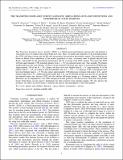| dc.contributor.author | Sullivan, Peter W. | |
| dc.contributor.author | Charbonneau, David | |
| dc.contributor.author | Deming, Drake | |
| dc.contributor.author | Dressing, Courtney D. | |
| dc.contributor.author | Latham, David W. | |
| dc.contributor.author | McCullough, Peter R. | |
| dc.contributor.author | Morton, Timothy D. | |
| dc.contributor.author | Winn, Joshua Nathan | |
| dc.contributor.author | Berta-Thompson, Zach | |
| dc.contributor.author | Woods, Deborah F. | |
| dc.contributor.author | Levine, Alan M | |
| dc.contributor.author | Ricker, George R | |
| dc.contributor.author | Vanderspek, Roland K | |
| dc.date.accessioned | 2015-11-24T19:29:42Z | |
| dc.date.available | 2015-11-24T19:29:42Z | |
| dc.date.issued | 2015-08 | |
| dc.date.submitted | 2015-02 | |
| dc.identifier.issn | 1538-4357 | |
| dc.identifier.issn | 0004-637X | |
| dc.identifier.uri | http://hdl.handle.net/1721.1/100041 | |
| dc.description.abstract | The Transiting Exoplanet Survey Satellite (TESS) is a NASA-sponsored Explorer mission that will perform a wide-field survey for planets that transit bright host stars. Here, we predict the properties of the transiting planets that TESS will detect along with the EB stars that produce false-positive photometric signals. The predictions are based on Monte Carlo simulations of the nearby population of stars, occurrence rates of planets derived from Kepler, and models for the photometric performance and sky coverage of the TESS cameras. We expect that TESS will find approximately 1700 transiting planets from 2 X 10[superscript 5] pre-selected target stars. This includes 556 planets smaller than twice the size of Earth, of which 419 are hosted by M dwarf stars and 137 are hosted by FGK dwarfs. Approximately 130 of the R < 2R[subscript ⊕] planets will have host stars brighter than K[subscript s] = 9. Approximately 48 of the planets with R < 2R[subscript ⊕] lie within or near the habitable zone ($0.2 < S/S[subscript ⊕] < 2); between 2 and 7 such planets have host stars brighter than K[subscript s] = 9. We also expect approximately 1100 detections of planets with radii 2–4 R[subscript ⊕], and 67 planets larger than 4 R[subscript ⊕]. Additional planets larger than 2 R[subscript ⊕] can be detected around stars that are not among the pre-selected target stars, because TESS will also deliver full-frame images at a 30-minute cadence. The planet detections are accompanied by over 1000 astrophysical false positives. We discuss how TESS data and ground-based observations can be used to distinguish the false positives from genuine planets. We also discuss the prospects for follow-up observations to measure the masses and atmospheres of the TESS planets. | en_US |
| dc.language.iso | en_US | |
| dc.relation.isversionof | http://dx.doi.org/10.1088/0004-637x/809/1/77 | en_US |
| dc.rights | Article is made available in accordance with the publisher's policy and may be subject to US copyright law. Please refer to the publisher's site for terms of use. | en_US |
| dc.source | IOP Publishing | en_US |
| dc.title | THE TRANSITING EXOPLANET SURVEY SATELLITE: SIMULATIONS OF PLANET DETECTIONS AND ASTROPHYSICAL FALSE POSITIVES | en_US |
| dc.type | Article | en_US |
| dc.identifier.citation | Sullivan, Peter W., Joshua N. Winn, Zachory K. Berta-Thompson, David Charbonneau, Drake Deming, Courtney D. Dressing, David W. Latham, et al. “THE TRANSITING EXOPLANET SURVEY SATELLITE: SIMULATIONS OF PLANET DETECTIONS AND ASTROPHYSICAL FALSE POSITIVES.” The Astrophysical Journal 809, no. 1 (August 10, 2015): 77. © 2015 The American Astronomical Society | en_US |
| dc.contributor.department | Lincoln Laboratory | en_US |
| dc.contributor.department | Massachusetts Institute of Technology. Department of Physics | en_US |
| dc.contributor.department | MIT Kavli Institute for Astrophysics and Space Research | en_US |
| dc.contributor.mitauthor | Sullivan, Peter W. | en_US |
| dc.contributor.mitauthor | Winn, Joshua Nathan | en_US |
| dc.contributor.mitauthor | Berta-Thompson, Zach | en_US |
| dc.contributor.mitauthor | Levine, Alan M. | en_US |
| dc.contributor.mitauthor | Ricker, George R. | en_US |
| dc.contributor.mitauthor | Vanderspek, Roland K. | en_US |
| dc.contributor.mitauthor | Woods, Deborah F. | en_US |
| dc.relation.journal | The Astrophysical Journal | en_US |
| dc.eprint.version | Final published version | en_US |
| dc.type.uri | http://purl.org/eprint/type/JournalArticle | en_US |
| eprint.status | http://purl.org/eprint/status/PeerReviewed | en_US |
| dspace.orderedauthors | Sullivan, Peter W.; Winn, Joshua N.; Berta-Thompson, Zachory K.; Charbonneau, David; Deming, Drake; Dressing, Courtney D.; Latham, David W.; Levine, Alan M.; McCullough, Peter R.; Morton, Timothy; Ricker, George R.; Vanderspek, Roland; Woods, Deborah | en_US |
| dc.identifier.orcid | https://orcid.org/0000-0003-2058-6662 | |
| dc.identifier.orcid | https://orcid.org/0000-0002-4265-047X | |
| mit.license | PUBLISHER_POLICY | en_US |
| mit.metadata.status | Complete | |
